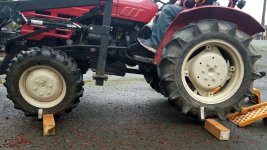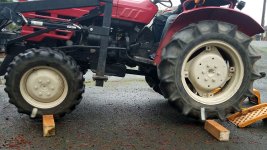Blake13
Member
I want to put some wider tires on my 2610d to get better flotation. I figured I would check the front to rear ratio so that I can make sure I am keeping the front tire rolling circumference lead perfect, as opposed to simply using the current tire ratio and getting something close. I'm going to include a long-winded explanation below the summary: 1, so anyone can check my work, 2, in case anyone is interested.
I will say, I am very surprised by the result, so PLEASE correct me if my methods are off.
Summary (quick, no math):
I jacked up the tractor and put a blocks down as a zero axis marker. I put a piece of tape on each tire at the block, engaged both axles in gear and recorded it on my phone for about a minute. Refer to pics at bottom. I counted revolutions to determine front to rear ratio of 1:0.6082. Using stock tire size rolling circumference and the experimentally determined ratio, it is calculated that the front tires lead by 9.5%. Based on this, a 13.6-24 tire would be better suited over the stock 11.2-24 rear tire. This is very surprising, so I question my methods.
One potential problem with my method; I locked the rear diff lock just in case, but with the front open differential could the spider gears be spinning slightly allowing the front two axles spin at different rates? Since there is no resistance i was assuming both front axles spin at the same exact rate. If this happens then it would obviously produce inaccurate result.
Update:
Jacking the entire tractor proved to be an unreliable method because while the front axle is suspended in the air, left and right sides will likely rotate at non equivalent rates (however proportional rates). Jacking the tractor from the side, forcing one side of each front and rear axle to remain in contact with the ground, stationary, ensures suspended axles are representative of gear ratio. Using this method the front:rear ratio 1:0.6341 was measured. This ratio is much closer to what was expected, showing the factory tire size have a 5.7% front lead.
Below is the trial using the first method, although not reliable, the methods and calculations are still useful.
_______________________________________
Long winded explanation with math:
After recording the wheels rotating, I watched the video and individually counted (double checked!) the number of revolutions for front and rear wheels. After exactly 17 rear revolutions the front turned almost 28. The tire lugs make a good measurement scale for this. It was shy (about 85%) of a lug-to-lug distance from turning a full 28. See "end" picture at bottom. The end picture is the video frame where rear tire hits revolution 17.
There are 17 lugs on the tire (don't confuse the 17 tire lugs with 17 rear tire revolutions, unrelated):
0.85 x 1/17 rev = .05 revs
1 - .05 revs = .95 revs
27 revs + .95 revs = 27.95 revs
So, the front tire does approximately 27.95 revolutions when the rear does 17.
And if you are thinking that my estimation of the front tire revs is not accurate enough, my accuracy is within 0.2%. This is because for certain, my observation is within one lug-to-lug distance. There are 17 tire lugs so 1/17th of a revolution over 28 revolutions . You can also see how the accuracy is dependent on how long the wheels spin, as revs go up percent error goes down.
(1/17) / 27.95 = 0.00210 = 0.2% error or 99.8% accurate
Or said another way, the front tire spins 27.95 +/- 0.03 revs (between 27.92 and 27.98 revs) for every 17 rear revs.
Now we can write this a few ways:
27.95:17 front to rear
1.644:1 front to rear
1:.6082 front to rear
Up until this point tire circumference was irrelevant. Now we can use this gear ratio to determine information like front tire lead for the factory tire set up. The factory tire arrangement is 7-16 front 11.2-24 rear. Carlisle literature for their Farm Specialist 7-16 lists a rolling circumference of 86.8 inches. The Farm Specialist 11.2-24 rolling circumference is 129.1 inches.
86.8" (front tire R.C.) x 1.644 (gear ratio) = 142.7" (theoretical matching rear tire R.C)
Rear tire must decrease by 5% R.C to give 5% lead to front tire
142.7" x 0.95 = 135.6" (theoretical rear tire R.C. to achieve 5% front tire lead)
So, acceptable stock rear tire R.C. range with 7-16 front tire: 135.6" to 142.7"
BUT the 11.2-24 is 129.1" R.C.
129.1" / 142.7" = .905 = 90.5%
This means the REAR tire is lagging by 9.5% with the factory tire size.
With a rolling circumference of 140", a 13.6-24 tire would be much better matched for the 7-16 wheel on this tractor... very weird.
_______________________________________
To corroborate this I never did like using the front wheel assist on pavement because it seemed to wind up more than I wanted. Disengaging was a bit tough, but not too bad.
Also to note, this determined ratio is almost exactly the golden ratio (1:0.618)! This must explain why the tire size relationship on the tractor is so pleasing to our eye :laughing:
Here is the start and end video frame of the experiment. I didn't include the video because I figure I don't need to prove that I can count to 28
Start

End

I will say, I am very surprised by the result, so PLEASE correct me if my methods are off.
Summary (quick, no math):
I jacked up the tractor and put a blocks down as a zero axis marker. I put a piece of tape on each tire at the block, engaged both axles in gear and recorded it on my phone for about a minute. Refer to pics at bottom. I counted revolutions to determine front to rear ratio of 1:0.6082. Using stock tire size rolling circumference and the experimentally determined ratio, it is calculated that the front tires lead by 9.5%. Based on this, a 13.6-24 tire would be better suited over the stock 11.2-24 rear tire. This is very surprising, so I question my methods.
One potential problem with my method; I locked the rear diff lock just in case, but with the front open differential could the spider gears be spinning slightly allowing the front two axles spin at different rates? Since there is no resistance i was assuming both front axles spin at the same exact rate. If this happens then it would obviously produce inaccurate result.
Update:
Jacking the entire tractor proved to be an unreliable method because while the front axle is suspended in the air, left and right sides will likely rotate at non equivalent rates (however proportional rates). Jacking the tractor from the side, forcing one side of each front and rear axle to remain in contact with the ground, stationary, ensures suspended axles are representative of gear ratio. Using this method the front:rear ratio 1:0.6341 was measured. This ratio is much closer to what was expected, showing the factory tire size have a 5.7% front lead.
Below is the trial using the first method, although not reliable, the methods and calculations are still useful.
_______________________________________
Long winded explanation with math:
After recording the wheels rotating, I watched the video and individually counted (double checked!) the number of revolutions for front and rear wheels. After exactly 17 rear revolutions the front turned almost 28. The tire lugs make a good measurement scale for this. It was shy (about 85%) of a lug-to-lug distance from turning a full 28. See "end" picture at bottom. The end picture is the video frame where rear tire hits revolution 17.
There are 17 lugs on the tire (don't confuse the 17 tire lugs with 17 rear tire revolutions, unrelated):
0.85 x 1/17 rev = .05 revs
1 - .05 revs = .95 revs
27 revs + .95 revs = 27.95 revs
So, the front tire does approximately 27.95 revolutions when the rear does 17.
And if you are thinking that my estimation of the front tire revs is not accurate enough, my accuracy is within 0.2%. This is because for certain, my observation is within one lug-to-lug distance. There are 17 tire lugs so 1/17th of a revolution over 28 revolutions . You can also see how the accuracy is dependent on how long the wheels spin, as revs go up percent error goes down.
(1/17) / 27.95 = 0.00210 = 0.2% error or 99.8% accurate
Or said another way, the front tire spins 27.95 +/- 0.03 revs (between 27.92 and 27.98 revs) for every 17 rear revs.
Now we can write this a few ways:
27.95:17 front to rear
1.644:1 front to rear
1:.6082 front to rear
Up until this point tire circumference was irrelevant. Now we can use this gear ratio to determine information like front tire lead for the factory tire set up. The factory tire arrangement is 7-16 front 11.2-24 rear. Carlisle literature for their Farm Specialist 7-16 lists a rolling circumference of 86.8 inches. The Farm Specialist 11.2-24 rolling circumference is 129.1 inches.
86.8" (front tire R.C.) x 1.644 (gear ratio) = 142.7" (theoretical matching rear tire R.C)
Rear tire must decrease by 5% R.C to give 5% lead to front tire
142.7" x 0.95 = 135.6" (theoretical rear tire R.C. to achieve 5% front tire lead)
So, acceptable stock rear tire R.C. range with 7-16 front tire: 135.6" to 142.7"
BUT the 11.2-24 is 129.1" R.C.
129.1" / 142.7" = .905 = 90.5%
This means the REAR tire is lagging by 9.5% with the factory tire size.
With a rolling circumference of 140", a 13.6-24 tire would be much better matched for the 7-16 wheel on this tractor... very weird.
_______________________________________
To corroborate this I never did like using the front wheel assist on pavement because it seemed to wind up more than I wanted. Disengaging was a bit tough, but not too bad.
Also to note, this determined ratio is almost exactly the golden ratio (1:0.618)! This must explain why the tire size relationship on the tractor is so pleasing to our eye :laughing:
Here is the start and end video frame of the experiment. I didn't include the video because I figure I don't need to prove that I can count to 28
Start

End

Last edited: